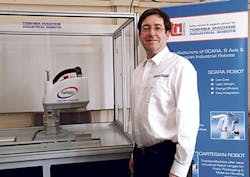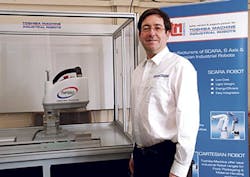A passion for robots
TM Robotics Founder and CEO Nigel Smith is passionate about robots. Not only does he see robot technology as increasing the productivity and efficiency of the plastics industry, he sees robots as job savers rather than job takers. Smith discussed his career and the role of automation in the plastics industry with PMM correspondent Lisa Jo Lupo.
Just the facts
WHO IS HE: Nigel Smith, founder and CEO of TM RoboticsHEADQUARTERS: Welwyn Garden City, EnglandFOUNDED: 2000SERVICE: Distributor of Toshiba Machines' industrial robots in Europe, the Middle East, Africa, and North and South America
You have had an interesting journey from working at Toshiba Corp. to founding TM Robotics in 2000. How did your time there influence your vision for TM Robotics?Smith: I was the industrial automation manager at Toshiba Corp. During my time there, the robot business was transferred to Toshiba Machine, which is a separate company. Because I had been working with Japanese companies for such a long time, having started with Toshiba in 1986, I've had a really good understanding of automation. In that time, the Japanese had embraced robotics, but Europeans and North Americans hadn't. So, when Toshiba Machine asked me to found [TM Robotics], I felt it was an opportunity to assist companies that were looking at automation in their factories to increase their productivity and efficiency, as well as promote the Toshiba robot brand.
A recent Association for Packaging and Processing Technologies report stated that data has the potential to improve all aspects of automation, but most manufacturers only harness a fraction of the potential. Do you agree? How can manufacturers meet the potential?Smith: The key here is the lack of understanding in the marketplace — still. Companies really don't understand how to embrace the robot technology so they can take on the automation that's needed to enhance their productivity and efficiency, and to remain competitive. The robot manufacturers need to get that message across. IoT [Internet of Things] monitoring of the vital signs of the machines can provide for preventive maintenance, so manufacturers can ensure continued production and reliability in their factories.
TM Robotics, especially with the SCARA line, has responded to users' fears about the difficulty of using industrial robots. Tell us about your engineering thought process, such as for the TH350.Smith: The key point is ease of programming, ease of use and simple troubleshooting. We are looking at making life easy for the maintenance engineers and installation engineers, but at the same time ensuring that the robots that are installed are high-speed and highly precise, but highly rigid and reliable. The TH350 is one of the range which initially [performed] small-part assembly. We've continued to develop robots in that field — we just launched the TH400, which is along the same lines of the TH350, but faster and even more accurate.
What are the challenges of robots and the smart factory?Smith: Not every factory is the same; you have to look at the right automation for the project. It's not an off-the-shelf offering. Education and communication are the keys. One example is that of a pharmaceutical factory where we have two molding machines and two robots. The robot takes a part from one machine and places it into another machine for the molding process. The second robot unloads it from the molding machine, inspects it, ensures it's good, and palletizes it.
Let's talk about the efficiency of ceiling-mounted SCARAs. Why are they growing in popularity?Smith: Because they minimize the space. If you have a ceiling-mounted SCARA, you can use it in a much tighter, compact area than you would if it were floor-mounted. From an efficiency point of view, if you have the robot mounted over a conveyor, you can use a smaller and quicker robot, again increasing the productivity. It's been particularly successful in the plastics industry to unload the molding machine. We have the robot — whether it's SCARA or six-axis — mounted above the molding machine and the robot would go into the molding machine and unload the part.
In terms of six-axis, what other innovations can the industry expect to see?Smith: The key point is the extended reach. We can work with the larger [injection molding machines] and machine tools. We can go up to about 650 tons [of clamping force] — the workhorse of injection molding machines, so we can now work with the most popular injection molding machines with the new range of the six-axis robot.
How will this impact the plastics industry?Smith: I think this trend will change things quite a lot in how the plastics industry uses automation. If you have a ceiling-mounted six-axis robot and you're taking a part from the molding machine, it actually enables you to do more work with the specific part that you're taking out, whether it's inspection, or whether it's assembly or whether it's packing.In the past, everyone has just used a classic Cartesian X-Y gantry-style robot to unload the parts from the molding machine. That's fine, but often customers want to do more — to embrace the technology and not have the Cartesian robot do just one specific task.
Can you talk about innovation of controllers on the six-axis?Smith: I think from a point of view of controllers, we should talk about software, because people want more integration with software. New software enables customers to do full 3-D simulation. You can bring in the files from peripheral devices — from a molding machine, a conveyor, a vibratory bowl feeder — and build your own work cell, which will enable high-performance 3-D simulation. There's also a simple vision-calibration tool so you can easily integrate the robot with a vision system for inspection, the recognition of parts, etc. It's that easier integration with peripheral parts that is coming more to the fore. Your robot is not just a robot anymore; it's a device you can communicate with.
How do you see automation evolving over the next decade in the North American plastics industry?Smith: Customers want to see more dexterity in the robots, they want to take automation to the next level, they want to do more with their robot. They want more bang for their buck, so to speak. They want to use the robot for inspection, take the part from the molding machine, pick up the part, show it to the vision camera, and, if it's good, move it downstream. So, definitely, more flexibility. And the cost of robots is coming down. In the past, the six-axis robot would be cost-prohibitive; now the robot is a commodity. It's a component in the automation process.
Why did the Japanese adopt industrial robotics ahead of the Europeans and Americans? We've heard that the Europeans are now ahead of the U.S. Do you agree? If so, what is holding us back? Smith: The Japanese had very strong manufacturing industries in varying sectors such as automotive and electronics. These sectors lend themselves to automation due to high throughput and high-speed but high-precision assembly/handling. To maximize production efficiency, the major Japanese corporate companies developed robots for their own production requirements. Ultimately, these were then sold as stand-alone products. Japan has space limitations in factories, a labor shortage and a high cost of living — all of which meant that the Japanese embraced the robot in advance of America and Europe.Europe is ahead of the American market in terms of automation mainly due to the lower labor costs in North America. As labor rates increase in North America, this will lend itself to more robot usage. As the market develops, more companies in the American market are looking to automate.
The plastics processing business is very strong right now in the U.S. Does that hinder or enhance the adoption of robotics? Why?Smith: A strong plastics industry is good news for the robot manufacturers. Robots are being used more and more to unload the molding machines as well as carry out more complex tasks, such as packing, inspection and assembly downstream of the molding machine. The efficient plastics manufacturers will embrace the technology so as to ensure that the goods they manufacture remain competitive in a highly competitive global market. TM Robotics does not currently offer cobots. Will it ever?Smith: Never say never, but, at the moment, we see the limitations of the cobot being speed and accuracy. It's like the new kid on the block — "I want to buy this new piece of equipment, so I go off and buy the cobot." But if they haven't done the risk assessment properly, once they get it to their factory, they find they paid top dollar for the cobot, but then they need to guard it because the health and safety risk assessment says it's not really a safe application for the cobot. So, the key thing is the risk assessment, making sure the application really is worthy of a collaborative one. Our stance is that there's room on the market for the industrial robot and the collaborative robot. Toshiba engineers are looking into [cobot] technology, but at the moment, we're sticking with our traditional SCARA and traditional robot.
What can someone interested in robots expect to see at NPE2018, both from TM Robotics and others?Smith: The complete solution … the injection molding machine and the robot, so we want to show the robot working with the injection molding machine in its fullest entirety.
What do you want your legacy to be?Smith: For customers and industries to embrace robots, because I'm passionate about robots. For TM Robotics — to be seen as a company responsible for improving production efficiency, reducing costs, and ensuring that local manufacturers keep manufacturing local. Robots should be seen as a job saver rather than taking jobs. We've lost so many production facilities to Asia, to China. If North America and the U.K. had embraced the automation technology sooner, the technology would have saved jobs and production would have stayed.

